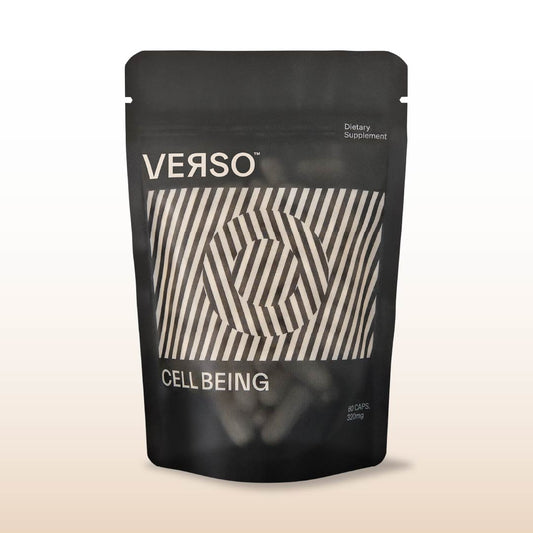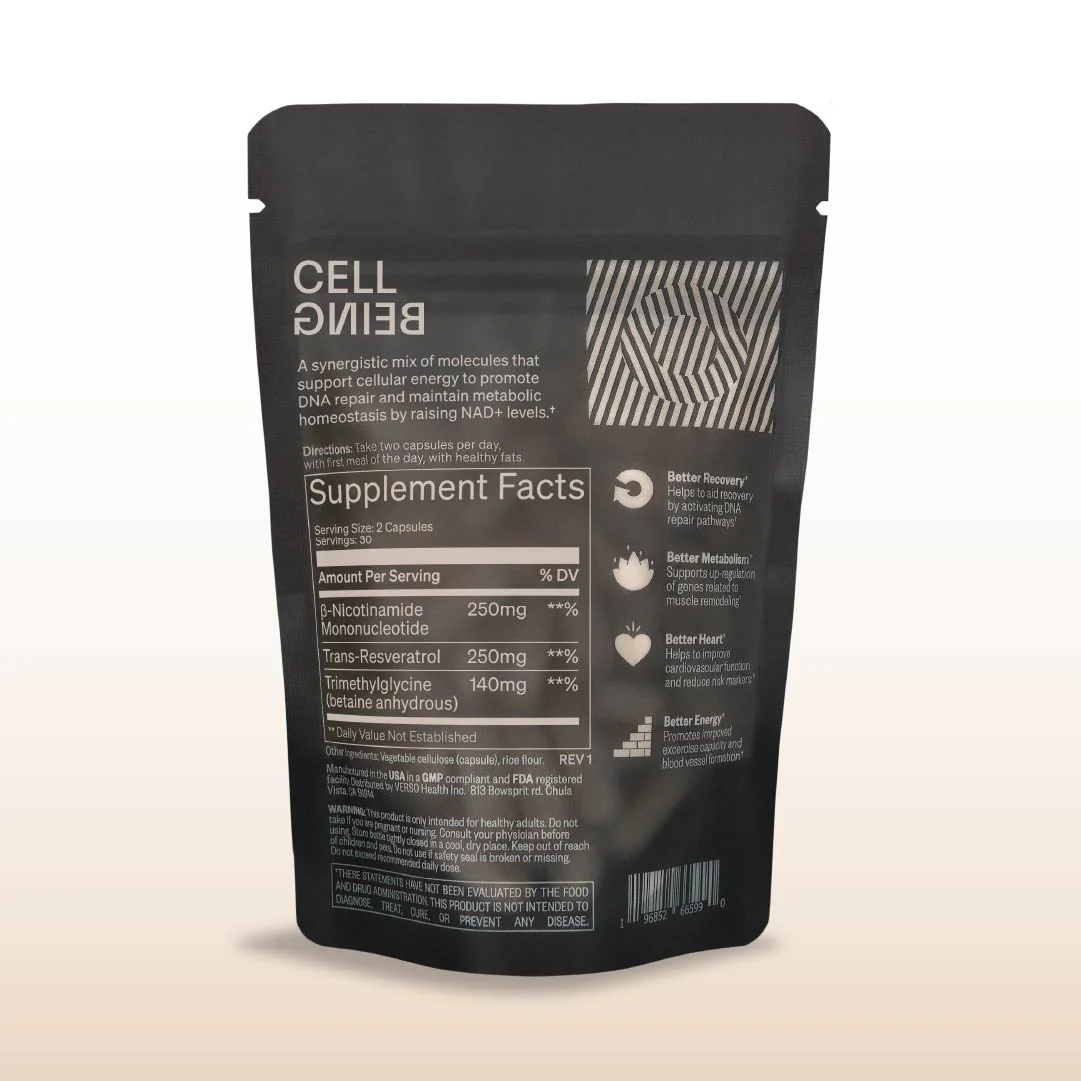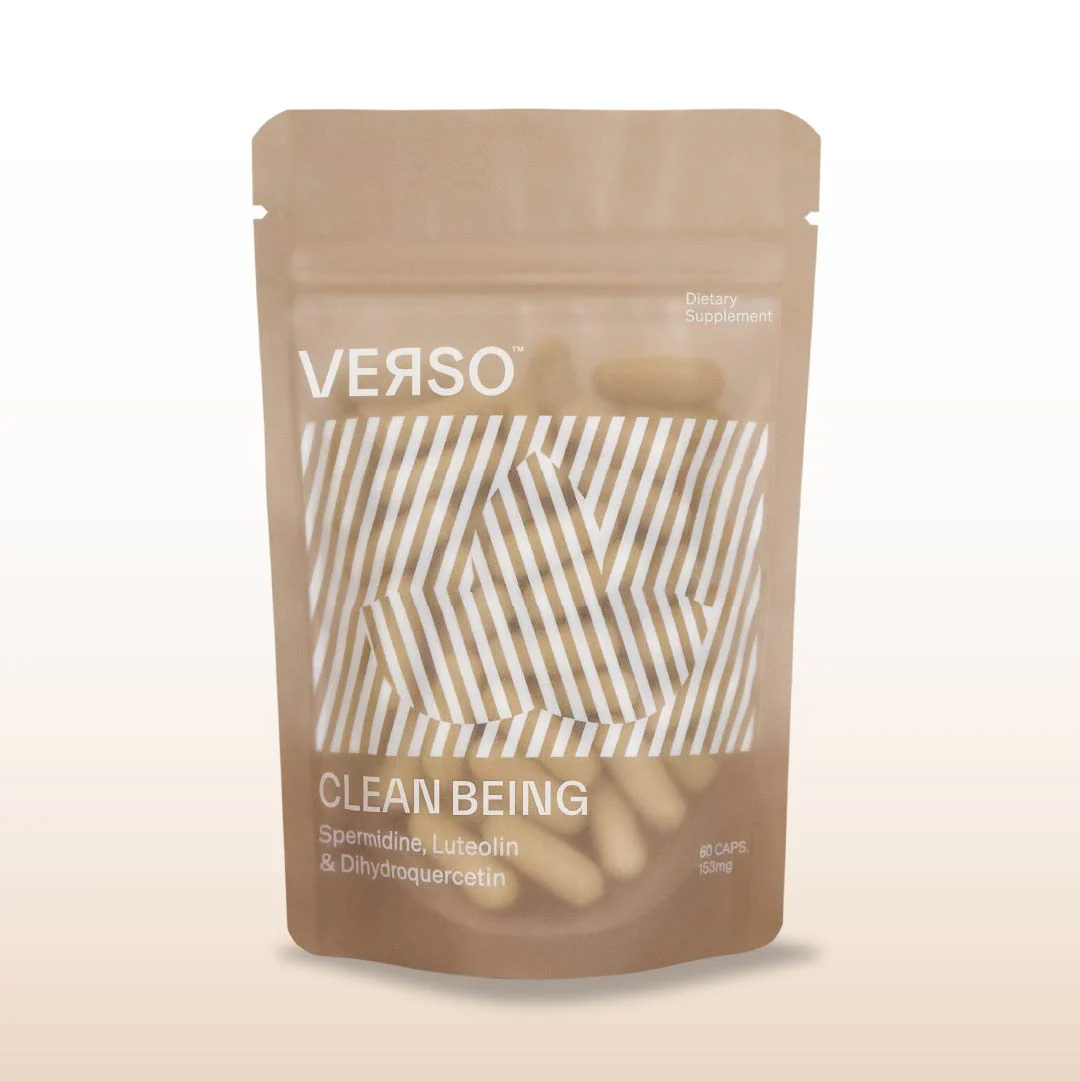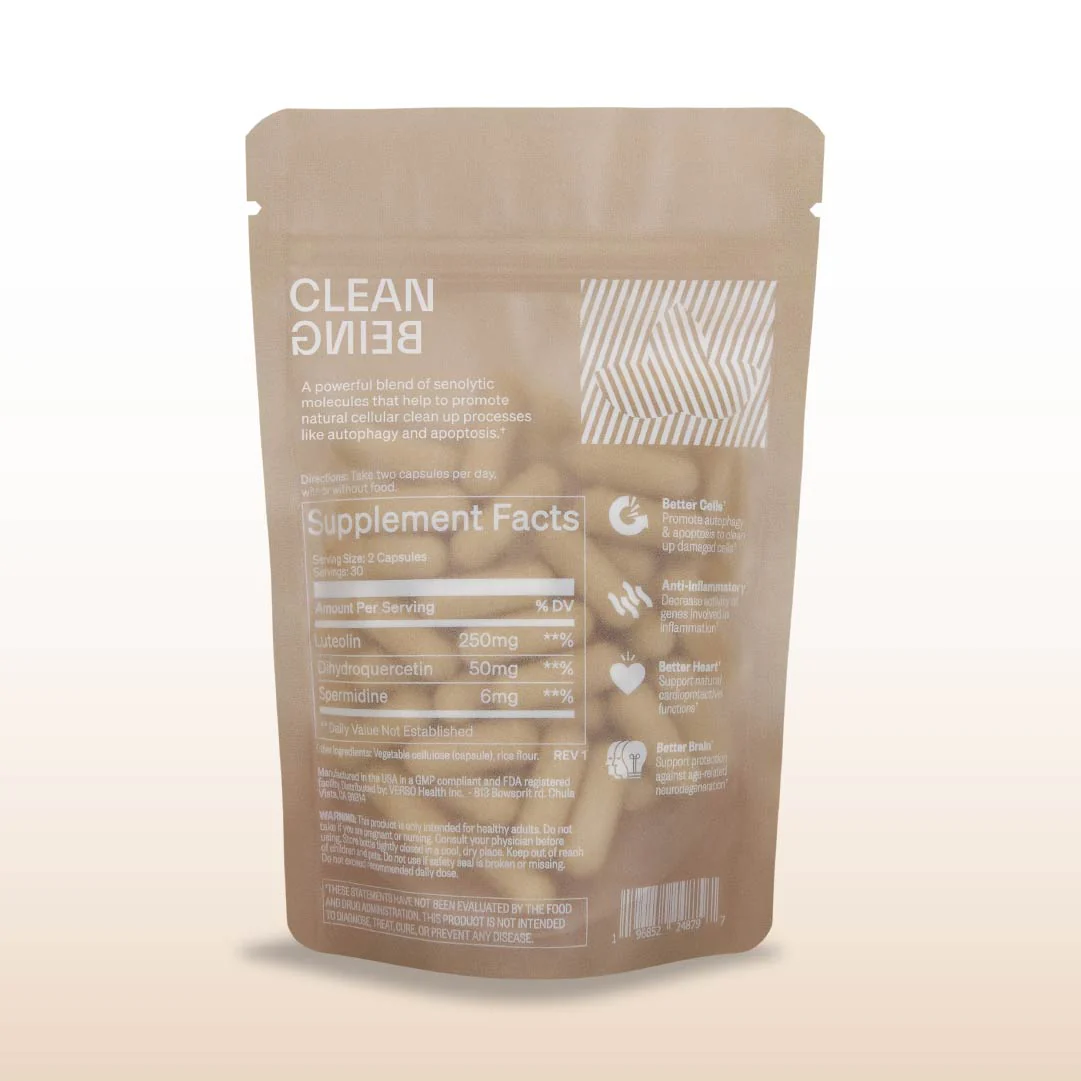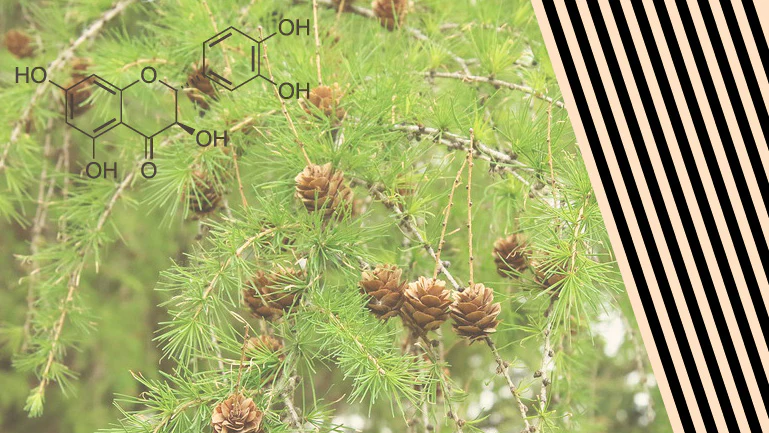
All things quercetin
Isoquercitrin, dihydroquercetin and α-glucosyl isoquercitrin, derivatives of quercetin, mimic many of the potential longevity benefits of their precursor molecule, including but not limited to: both antioxidant and anti-inflammatory activity, protection from cancer, neuroprotection, improvement of metabolic health, and cardioprotection.
What is quercetin?
Quercetin, a metabolite of the phytonutrient rutin, is a plant flavonoid compound which can be found in a wide array of foods from raw capers, red hot peppers, onions, asparagus, and cranberries to garlic, and even medicinal plants like ginkgo and St. John’s wort(Li). The most common supplemental form is quercetin aglycone, which confers a wide array of health benefits, but is not commonly observed in nature (Andres, Han, Lu). Throughout research, quercetin is seen as an anti-aging compound, however in its most common supplemental form its benefits are limited due to poor oral bioavailability and lack of solubility in water(Cai). Research indicates that flavonoids, specifically quercetin, may alleviate chronic health conditions such as neurodegenerative disease, metabolic conditions, hypertension, arthritis, lung and kidney disease and may also be beneficial in combating other diseases associated with age (Ulusoy).
What are isoquercitrin, alpha glycosyl isoquercitrin (AGIQ) and dihydroquercetin?
Isoquercitrin, AGIQ and dihydroquercetin, are plant phytochemical compounds derived from quercetin. Isoquercitrin is a form of quercetin which is commonly found in plants in nature(Makino). AGIQ is a modified flavonol mixture of isoquercitrin and its α-glucosylated derivatives. It is derived from the enzymatic glycosylation of rutin(Akiyama). Dihydroquercetin rapidly oxidizes into quercetin (Rogozin). Both of these quercetin derivatives have higher absorption and bioavailability when compared to quercetin(Makino, Hobbs). These first two compounds together are able to enter the bloodstream faster than quercetin itself, while the latter is dependent on the preparation. In fact, one study compared the bioavailability of all 3 molecules and found that in mice the bioavailability was 2% for quercetin, 12% for isoquercitrin, and 35% for a-glycosyl isoquercitrin (Makino). Furthermore, research in mice has shown that AGIQ is even better absorbed than isoquercitrin(Makino, Valentova). Due to higher bioavailability and absorption rates, isoquercitrin and AGIQ are believed to confer many of the same longevity benefits of quercetin – although research confirming this is still in its infancy(Hobbs, Valentova). The benefits of quercetin and its derivatives are discussed below.
What is the mechanism?
Quercetin and antioxidant capacities
One of the main mechanisms in which quercetin and its derivatives exert longevity benefits is through antioxidant capacities. The antioxidant quercetin is able to scavenge cell-damaging free radicals (ROS and RNS) due to an ability to increase absorption of vitamin C, which acts as an antioxidant, to promote healthy glutathione levels – one of the most powerful antioxidants in the human body, as well as to upregulate NrF2, one of the main controllers of antioxidant genes (Procha, Tanigawa). Antioxidant activity prevents cellular and DNA damage, as well as chronic inflammation from free radicals run amok, or oxidative stress. This is significant because oxidative stress has a role in the pathophysiology or exacerbation of many diseases associated with aging, such as Alzeimers disease (AD), atherosclerosis and cancer(Reuter, Khan). Just as research shows that quercetin induces antioxidant activity, evidence in both humans and animal research shows that isoquercitrin, AGIQ and dihydroquercetin also reduce oxidative damage via exhibiting antioxidant tendencies(Omi, Kim, Kong, Li 2011, Salucci, Salem, Boligon, Soundararajan, Makena). All in all, these quercetin derivatives display several cytoprotective properties, including inhibiting lipid peroxidation, increasing the absorption of vitamin C, activating NrF2, scavenging free radicals, and chelating redox-active metals (Park, De Araújo, Heim). There is evidence that suggests isoquercitrin has higher antioxidant activity than quercetin, supporting the hypothesis that due to higher bioavailability, quercetin derivatives exert many of the same benefits as quercetin, only enhanced(Li X).
Due to quercetin’s antioxidant activity, it is no surprise that quercetin is well-regarded as an anti-inflammatory compound (Li Y). Inflammation is an immune response to damage, however, chronic inflammation contributes to disease state. Isoquercitrin has demonstrated an ability to reduce the production of several pro-inflammatory factors such as prostaglandin E2, and interleukin-6 in human bone cancer cells(Hammer, Kim – IL-6). Additionally, isoquercitrin protected mice from carrageenan-induced inflammation(Morikawa). Isoquercitrin also inhibits the inflammatory activity of advanced glycation end products (AGEs), which form when proteins react with reducing sugars, such as in processed foods(Jang). On the other hand isoquercitrin might strengthen the immune system and inflammatory response, in acute illness, which is necessary for recovery(Valentova – Immune). Dihydroquercetin has also been noted to reduce brain inflammation in mice (Qadir). Research demonstrating the same using AGIQ is needed. Quercetin and its derivatives ability to fight inflammation, as well as to activate NrF2, increase glutathione levels, and scavenge free radicals, is one of its main mechanisms of conferring health benefits.
Quercetin and hallmarks of aging mechanisms
The hallmarks of aging are common denominators of aging which include: “genomic instability, telomere attrition, epigenetic alterations, loss of proteostasis, deregulated nutrient-sensing, mitochondrial dysfunction, cellular senescence, stem cell exhaustion, and altered intercellular communication”(Lopez-Otin). Research shows that quercetin in part impacts cellular senescence, loss of proteostasis, and mitochondrial dysfunction. Senescent cells, otherwise known as “zombie cells’,” evade programmed death, secrete proinflammatory substances and accumulate with age(Lopez-otin). Although there is no direct evidence that AGIQ, isoquercitrin or dihydroquercetin are senolytic compounds, or in other words, compounds that help clear senescent cells – there is some evidence that quercetin, at least in combination with the cancer drug Dasatinib has a senolytic effect on intestinal senescent cells(Saccon). In this study, mice administered dasatinib + quercetin, also had a 36% increase in lifespan and improved measures of healthspan as well(Saccon). Another study in vitro showed that quercetin reduced renal tubular epithelial cell senescence likely via activating SIRT-1 and inducing mitophagy, the beneficial clearing of damaged mitochondria(Liu, Liu P, Tao). Mitophagy contributes to mitochondrial dysfunction, a hallmark of aging and hence, is impaired with aging and diseases of aging(Diot). In mice, quercetin improves mitochondrial biogenesis in the brain and muscle – therefore quercetin possesses the ability to both clear out damaged mitochondria and stimulate the generation of new functional mitochondria(Davis). More research is needed to further investigate the role of quercetin and its derivatives as senolytic compounds as well as activators of mitophagy and mitochondrial biogenesis.
Another hallmark of aging, loss of proteostasis has been shown to be mediated by quercetin in worms(Civelek). Proteostasis guarantees that there is no improper folding of proteins, which can contribute to aging(Lopez-Otin, Civelek). Although there is no or limited direct research investigating AGIQ, isoquercitrin and dihydroquercetin and these hallmarks of aging, due to their relationship with quercetin, their roles are promising.
Quercetin and the autophagy mechanism
Evidence suggests that in animal models of Alzheimer’s disease(AD) and cancer, quercetin is able to induce cellular autophagy, the body’s process of clearing out damaged cells(SOURCE). AD pathogenesis is marked by both inflammation and the accumulation of amyloid partially due to impaired neuronal autophagy. The induction of autophagy by quercetin was seen in rodent models of AD where quercetin also cleared amyloid substance attributed to both increasing AMPK activity and attenuating mitochondrial dysfunction(Khan). Similarly, in an AD mouse model, isoquercitrin also reduces amyloid plaque formation in the brain(Kim J). However, research investigating the roles of quercetin derivatives and neuronal autophagy is needed. AD aside, quercetin has also been noted to activate pro-apoptotic autophagy in human lung cancer cell lines, epithelial cancer cells, and liver cancer cells, meaning that in vitro, quercetin is able to promote the clearing out of cancer cells and also the killing of cancer cells(Rauf). Similarly, research confirms that isoquercitrin is able to induce pro-apoptotic autophagy in mouse bladder, liver, and human prostate cancer cells(Wu P, Queires, Shui, Matsubara). In terms of a mechanism, researchers attribute induction of autophagy to the activation of AMPK and SIRT-1 pathways and the inhibition of the mTOR pathway – all involved in slowing the processes of aging(Guo, Shui, Hasima).
What are the health benefits of quercetin and its derivatives?
Quercetin and cancer
Aside from inducing autophagy in diseased cells including cancer, quercetin also exerts several anti-cancer effects in cell studies as well as in animal studies, promoting apoptosis of tumor cells and cancer cell lines, as well as decreasing tumor volume(Hashemzaei). Unsurprisingly, all three derivatives also exert chemoprotective effects. Research in human and rat cells has shown confirmation of isoquercitrin’s role in combating cancer. Isoquercitrin suppressed the activation and upregulation of pro-cancer proteins and enzymes as well as blocked cancer fuel supply, or angiogenesis – all implicated in cancer metastasis(Kong, Matsubara). AGIQ has been shown to suppress tumor development in animal models (Fujii, Hara, Kangawa, Kimura). Additionally, dihydroquercetin has anti-cancer effects in in vitro studies on: ovarian, colon, prostate, breast, and liver cancers, likely via antioxidant capacities as well as fatty acid synthase and cell growth inhibition (SOURCES). These anticancer effects are likely due to an ability to inhibit certain xenobiotic-metabolizing enzymes, or enzymes that remove foreign substances in the human body, as well as the ability to induce other anti-proliferative cellular changes(Kang, Chaudhary, Martinez, Chen, You). These effects are seen across different types of cancer, including: breast, pancreas, liver, cerebral, lymphoproliferative, fibrosarcoma, prostatic and colon (Orfali).
Quercetin and neuroprotection
A wealth of research shows quercetin’s positive impact on brain health, aside from the previously mentioned significant clearing of amyloid plaques in AD animal research. The positive impacts include replenishing facets of brain health, protecting from brain injury, mediating brain inflammation, supporting synaptic plasticity and improving general and spatial awareness, which are all implicated in diseases of neurodegeneration (Ulusoy, Khan). Research demonstrates that through preventing neurotoxin-caused oxidative stress, mitochondrial dysfunction, and cellular apoptosis, isoquercitrin protects from neurotoxicity (Chen L). Furthermore, relevant to brain injury, isoquercitrin promotes brain cell, neurite, synapse health and peripheral nerve regeneration, likely through antioxidant activity and inhibiting oxidative stress (Palazzolo, Qiu). AGIQ has been shown to confer neuroprotective benefits in mouse studies, supporting synaptic plasticity, and memory health as well as potentially attenuating stress, and in a rat autism model, improving hippocampal neurogenesis(Okada, Okano). Dihydroquercetin has also been noted to reduce brain inflammation in mice (Qadir).
Quercetin and metabolic health
Research has shown that quercetin improves factors of metabolic health including glucose levels, hyperlipidemia, obesity, blood pressure via modulating hormones, reducing insulin resistance, regulating insulin and blocking the calcium channel, some of which is attributed to antioxidant capacity(Hosseini). One such study using a diabetic mouse model, showed that quercetin decreased fasting blood glucose concentration, and also, after 35 days resulted in decreased plasma C-peptide, triglyceride, total cholesterol and blood urea nitrogen levels. Tolerance of glucose was also improved and pancreatic immunoreactivity was as well(Zhang). Mouse studies have shown that isoquercitrin has a role in regulating lipids and blood sugar levels(Panda, Paulo). In another diabetic mouse model, isoquercitrin supplementation inhibited blood glucose spike, as well as improved insulin sensitivity (Zhang L). In induced-obesity mouse models, isoquercitrin attenuated obesity (Kim J). Similarly, in mice, AGIQ confers a variety of metabolic benefits including, improved glucose homeostasis, decreased white adipose tissue weight, and improved regulation of energy metabolism (Jiang, Trakooncharoenvit). Human research to demonstrate the same is underway.
Quercetin and cardiovascular health
Research has shed a light on the anti-inflammatory heart protective, blood pressure reducing, blood vessel protective and cholesterol reducing effects of quercetin(Ulusoy). In a human study, quercetin lowered LDL oxidation, increased levels of which are associated with coronary heart disease, amongst male participants (Chopra). Further research including hypertensive human participants suggests that quercetin is able to reduce blood pressure, thereby supporting cardiovascular health(Edwards). Similarly, isoquercitrin and AGIQ confer heart benefits. In hypertensive rats, isoquercitrin exerts an anti-hypertensive effect by inhibiting an enzyme associated with high blood pressure and acting as a diuretic (Emura). In hypertensive mice, AGIQ has been shown to have enhanced anti-hypertensive effects compared to quercetin, including suppressing an increase in systolic blood pressure, likely due to increasing endothelial NO levels and antioxidant activity(Emura). Additionally, AGIQ has been shown to protect against atherosclerosis, reducing atherosclerotic lesion area, and producing plaque-stabilizing effects in a mouse atherosclerosis model(Motoyama). Plaque-stabilizing effects are in part attributable to antioxidant capacity. Interestingly, these heart healthy benefits also translate into human research, where a trial including participants at risk of cardiovascular disease showed that AGIQ improved endothelial function(Bondonno). Additionally, dihydroquercetin has been shown to promote heart health in healthy human volunteers via lowering LDL cholesterol(Kostyuk et al., 2003).
Quercetin and other health benefits
Quercetin exerts several other health benefits which might be relevant to isoquercitrin and a-glycosyl isoquercitrin, including reducing skin aging, improving wound healing, improving conditions of rheumatoid arthritis, lung and kidney disease, non-alcoholic fatty liver disease, as well as combating viral infections (Edwards, Ulusoy, Liu). Additionally, in mice quercetin supplementation has been shown to reduce muscle mass atrophy(Le). In a mouse model of chronic obstructive pulmonary disease (COPD), quercetin reduced lung inflammation, oxidative stress, and virus-related progression of COPD, trials are now recruiting to mimic these effects in adults with lung disease(Han). In a human study with young athletes, quercetin supplementation increased muscle mass. The results in both of these studies are likely due in part to quercetin enhancing mitochondrial health – however, more research is needed to confirm this mechanism(Omi). Furthermore, quercetin has been shown to increase intracellular NAD+ levels, which decline with age. Quercetin does this by inhibiting the inflammatory factor CD38, which increases with age and disrupts NAD+ function (Escande). This is significant, because NAD+ exists within every cell, interacts with longevity genes, namely sirtuins, and has a huge effect on aging and longevity as well as lifespan in animal models(Yaku). The effects of isoquercitrin and a-glycosyl isoquercitrin across these measures are likely the same, but still need to be confirmed through research. Aside from all of the benefits outlined above, isoquercitrin and AGIQ also improve allergic response via modulating inflammation, and improving liver health (Fujii, Hara, Kimura, Kuwata, Fernandez, Rogerio, Hirano). Finally, through inhibiting inflammation and oxidative stress, isoquercitrin has been shown to alleviate denervated muscular atrophy(Shen). The potential benefits of quercetin and its derivatives are wide, – research will serve to further elucidate these benefits for human medical use.
Conclusion
There is a wealth of knowledge supporting the benefits of quercetin, however, as a supplement quercetin, usually found in the aglycone form, falls short due to poor oral bioavailability and lack of solubility in water. To mediate this disadvantage, quercetin derivatives have been shown to have better bioavailability, absorption, and water solubility, including both isoquercitrin and α-glucosyl isoquercitrin. These derivatives of quercetin, mimic many of the potential longevity benefits of their precursor molecule, including protection from cancer, neuroprotection, improvement of metabolic health, and cardioprotection. Activation of the Nrf2 pathway by quercetin and its derivatives is significant to these benefits. Since inflammation, antioxidant activity, and mitochondrial dysfunction are involved in the pathogenesis of many conditions of aging, these purported benefits can be attributed in part to both overall antioxidant and anti-inflammatory mechanisms. Although more research is needed to confirm, the research attributing many of these benefits to improvement of mitochondrial health is promising. While there might be areas in which isoquercitrin and α-glucosyl isoquercitrin are less impactful, research has begun to show that these molecules could enhance several of the longevity benefits of quercetin.

Author: Jacqueline Seymour
Jacki is a Master’s student at USC, home of Dr. Valter Longo’s Longevity Institute, where she’s studying her passion for life: Gerontology(the science of aging) and Nutrition.
Resources:
- Akiyama T, Washino T, Yamada T, Koda T, and Maitani T. Constituents of enzymatically modified isoquercitrin and enzymatically modified rutin (extract). Food Hyg Safe Sci. 41: 54–60. 2000.
- Andres, Susanne, et al. “Safety Aspects of the Use of Quercetin as a Dietary Supplement.” Molecular Nutrition & Food Research, vol. 62, no. 1, 2017, p. 1700447., https://doi.org/10.1002/mnfr.201700447.
- Boligon, Aline Augusti, et al. “Protective Effects of Extracts and Flavonoids Isolated from Scutia Buxifolia Reissek against Chromosome Damage in Human Lymphocytes Exposed to Hydrogen Peroxide.” Molecules, vol. 17, no. 5, 2012, pp. 5757–5769., https://doi.org/10.3390/molecules17055757.
- Bondonno, Nicola P., et al. “Enzymatically Modified Isoquercitrin Improves Endothelial Function in Volunteers at Risk of Cardiovascular Disease.” British Journal of Nutrition, vol. 123, no. 2, 2019, pp. 182–189., https://doi.org/10.1017/s0007114519002137.
- Cai, X., et al. “Bioavailability of Quercetin: Problems and Promises.” Current Medicinal Chemistry, vol. 20, no. 20, 2013, pp. 2572–2582., https://doi.org/10.2174/09298673113209990120.
- CHAUDHARY, A, and K WILLETT. “Inhibition of Human Cytochrome CYP1 Enzymes by Flavonoids of St. John’s Wort.” Toxicology, vol. 217, no. 2-3, 2006, pp. 194–205., https://doi.org/10.1016/j.tox.2005.09.010.
- Chen, Lei, et al. “Protective Effects of Isoquercitrin on Streptozotocin‐Induced Neurotoxicity.” Journal of Cellular and Molecular Medicine, vol. 24, no. 18, 2020, pp. 10458–10467., https://doi.org/10.1111/jcmm.15658.
- CHEN, QUAN, et al. “ISOQUERCITRIN Inhibits the Progression of Pancreatic Cancer in Vivo and in Vitro by Regulating Opioid Receptors and the Mitogen-Activated Protein Kinase Signalling Pathway.” Oncology Reports, vol. 33, no. 2, 2014, pp. 840–848., https://doi.org/10.3892/or.2014.3626.
- Chopra M, Fitzsimons PE, Strain JJ, Thurnham DI, Howard AN. Nonalcoholic red wine extract and quercetin inhibit LDL oxidation without affecting plasma antioxidant vitamin and carotenoid concentrations. Clin Chem. 2000 Aug;46(8 Pt 1):1162-70. PMID: 10926898.
- Civelek, Mehtap, et al. “The Polyphenol Quercetin Protects from Glucotoxicity Depending on the Aggresome in Caenorhabditis Elegans.” European Journal of Nutrition, vol. 59, no. 2, 2019, pp. 485–491., https://doi.org/10.1007/s00394-019-01917-6.
- Davis, J. Mark, et al. “Quercetin Increases Brain and Muscle Mitochondrial Biogenesis and Exercise Tolerance.” American Journal of Physiology-Regulatory, Integrative and Comparative Physiology, vol. 296, no. 4, 2009, https://doi.org/10.1152/ajpregu.90925.2008.
- De Araújo, Maria Elisa, et al. “Enzymatic De-Glycosylation of Rutin Improves Its Antioxidant and Antiproliferative Activities.” Food Chemistry, vol. 141, no. 1, 2013, pp. 266–273., https://doi.org/10.1016/j.foodchem.2013.02.127.
- Diot, Alan, et al. “Mitophagy Plays a Central Role in Mitochondrial Ageing.” Mammalian Genome, vol. 27, no. 7-8, 2016, pp. 381–395., https://doi.org/10.1007/s00335-016-9651-x.
- Edwards, Randi L., et al. “Quercetin Reduces Blood Pressure in Hypertensive Subjects.” The Journal of Nutrition, vol. 137, no. 11, 2007, pp. 2405–2411., https://doi.org/10.1093/jn/137.11.2405.
- EMURA, Kazuhiro, et al. “Effect of Enzymatically Modified Isoquercitrin in Spontaneously Hypertensive Rats.” Journal of Nutritional Science and Vitaminology, vol. 53, no. 1, 2007, pp. 68–74., https://doi.org/10.3177/jnsv.53.68.
- Escande, C., et al. “Flavonoid Apigenin Is an Inhibitor of the NAD+ASE CD38: Implications for Cellular NAD+ Metabolism, Protein Acetylation, and Treatment of Metabolic Syndrome.” Diabetes, vol. 62, no. 4, 2012, pp. 1084–1093., https://doi.org/10.2337/db12-1139.
- Fernandez, Jacquelina, et al. “Isoquercitrin from Argemone Platyceras Inhibits Carbachol and Leukotriene d4-Induced Contraction in Guinea-Pig Airways.” European Journal of Pharmacology, vol. 522, no. 1-3, 2005, pp. 108–115., https://doi.org/10.1016/j.ejphar.2005.08.046.
- Fujii, Yuta, et al. “Effect of Enzymatically Modified Isoquercitrin on Preneoplastic Liver Cell Lesions Induced by Thioacetamide Promotion in a Two-Stage Hepatocarcinogenesis Model Using Rats.” Toxicology, vol. 305, 2013, pp. 30–40., https://doi.org/10.1016/j.tox.2013.01.002.
- Guo, Hengjuan, et al. “Quercetin Induces pro‐Apoptotic Autophagy via SIRT1 / AMPK Signaling Pathway in Human Lung Cancer Cell Lines A549 and H1299 in Vitro.” Thoracic Cancer, 2021, https://doi.org/10.1111/1759-7714.13925.
- Hammer, Kimberly D., et al. “Inhibition of Prostaglandin E2 Production by Anti-Inflammatory Hypericum Perforatum Extracts and Constituents in raw264.7 Mouse Macrophage Cells.” Journal of Agricultural and Food Chemistry, vol. 55, no. 18, 2007, pp. 7323–7331., https://doi.org/10.1021/jf0710074.
- Han, Meilan K, et al. “Randomised Clinical Trial to Determine the Safety of Quercetin Supplementation in Patients with Chronic Obstructive Pulmonary Disease.” BMJ Open Respiratory Research, vol. 7, no. 1, 2020, https://doi.org/10.1136/bmjresp-2018-000392.
- Hara, Shintaro, et al. “Tumor Suppression Effects of Bilberry Extracts and Enzymatically Modified Isoquercitrin in Early Preneoplastic Liver Cell Lesions Induced by Piperonyl Butoxide Promotion in a Two-Stage Rat Hepatocarcinogenesis Model.” Experimental and Toxicologic Pathology, vol. 66, no. 5-6, 2014, pp. 225–234., https://doi.org/10.1016/j.etp.2014.02.002.
- Hashemzaei, Mahmoud, et al. “Anticancer and Apoptosis-Inducing Effects of Quercetin in Vitro and in Vivo.” Oncology Reports, vol. 38, no. 2, 2017, pp. 819–828., https://doi.org/10.3892/or.2017.5766.
- Hasima, N, and B Ozpolat. “Regulation of Autophagy by Polyphenolic Compounds as a Potential Therapeutic Strategy for Cancer.” Cell Death & Disease, vol. 5, no. 11, 2014, https://doi.org/10.1038/cddis.2014.467.
- Heim, Kelly E, et al. “Flavonoid Antioxidants: Chemistry, Metabolism and Structure-Activity Relationships.” The Journal of Nutritional Biochemistry, vol. 13, no. 10, 2002, pp. 572–584., https://doi.org/10.1016/s0955-2863(02)00208-5.
- Hirano, Toru, et al. “Preventative Effect of a Flavonoid, Enzymatically Modified Isoquercitrin on Ocular Symptoms of Japanese Cedar Pollinosis.” Allergology International, vol. 58, no. 3, 2009, pp. 373–382., https://doi.org/10.2332/allergolint.08-oa-0070.
- Hobbs, Cheryl A., et al. “Comprehensive Evaluation of the Flavonol Anti-Oxidants, Alpha-Glycosyl Isoquercitrin and Isoquercitrin, for Genotoxic Potential.” Food and Chemical Toxicology, vol. 113, 2018, pp. 218–227., https://doi.org/10.1016/j.fct.2017.12.059.
- Hosseini, Azar, et al. “Quercetin and Metabolic Syndrome: A Review.” Phytotherapy Research, vol. 35, no. 10, 2021, pp. 5352–5364., https://doi.org/10.1002/ptr.7144.
- Jang, Dae Sik, et al. “Effects of Compounds Isolated from the Fruits OfRumex Japonicuson the Protein Glycation.” Chemistry & Biodiversity, vol. 5, no. 12, 2008, pp. 2718–2723., https://doi.org/10.1002/cbdv.200890226.
- Jiang, Hao, et al. “Enzymatically Modified Isoquercitrin Promotes Energy Metabolism through Activating Ampkα in Male C57BL/6 Mice.” Food & Function, vol. 10, no. 8, 2019, pp. 5188–5202., https://doi.org/10.1039/c9fo01008d.
- Kang, I. “Biphasic Effects of the Flavonoids Quercetin and Naringenin on the Metabolic Activation of 2-Amino-3,5-Dimethylimidazo[4,5-f]Quinoline by Salmonella Typhimurium TA1538 Co-Expressing Human Cytochrome P450 1A2, NADPH-Cytochrome P450 Reductase, and Cytochrome B5.” Mutation Research/Fundamental and Molecular Mechanisms of Mutagenesis, vol. 545, no. 1-2, 2004, pp. 37–47., https://doi.org/10.1016/j.mrfmmm.2003.08.002.
- Kangawa, Yumi, et al. “Cilostazol and Enzymatically Modified Isoquercitrin Attenuate Experimental Colitis and Colon Cancer in Mice by Inhibiting Cell Proliferation and Inflammation.” Food and Chemical Toxicology, vol. 100, 2017, pp. 103–114., https://doi.org/10.1016/j.fct.2016.12.018.
- Khan, Haroon, et al. “Neuroprotective Effects of Quercetin in Alzheimer’s Disease.” Biomolecules, vol. 10, no. 1, 2019, p. 59., https://doi.org/10.3390/biom10010059.
- Kim, A Ryun, et al. “Phenolic Compounds with IL-6 Inhibitory Activity from Aster Yomena.” Archives of Pharmacal Research, vol. 37, no. 7, 2013, pp. 845–851., https://doi.org/10.1007/s12272-013-0236-x.
- Kim, Byung-Hak, et al. “Relative Antioxidant Activities of Quercetin and Its Structurally Related Substances and Their Effects on NF-ΚB/CRE/AP-1 Signaling in Murine Macrophages.” Molecules and Cells, vol. 35, no. 5, 2013, pp. 410–420., https://doi.org/10.1007/s10059-013-0031-z.
- Kim, Ji Hyun, et al. “The Protective Effects of Acer Okamotoanum and Isoquercitrin on Obesity and Amyloidosis in a Mouse Model.” Nutrients, vol. 12, no. 5, 2020, p. 1353., https://doi.org/10.3390/nu12051353.
- Kimura, Masayuki, et al. “Involvement of Multiple Cell Cycle Aberrations in Early Preneoplastic Liver Cell Lesions by Tumor Promotion with Thioacetamide in a Two-Stage Rat Hepatocarcinogenesis Model.” Experimental and Toxicologic Pathology, vol. 65, no. 7-8, 2013, pp. 979–988., https://doi.org/10.1016/j.etp.2013.01.012.
- Kong, Chang-Suk, et al. “Flavonoid Glycosides Isolated from Salicornia Herbacea Inhibit Matrix Metalloproteinase in HT1080 Cells.” Toxicology in Vitro, vol. 22, no. 7, 2008, pp. 1742–1748., https://doi.org/10.1016/j.tiv.2008.07.013.
- Kuwata, Kazunori, et al. “Concomitant Apoptosis and Regeneration of Liver Cells as a Mechanism of Liver-Tumor Promotion by β-Naphthoflavone Involving TNFΑ-Signaling Due to Oxidative Cellular Stress in Rats.” Toxicology, vol. 283, no. 1, 2011, pp. 8–17., https://doi.org/10.1016/j.tox.2011.01.020.
- Le, Ngoc Hoan, et al. “Quercetin Protects against Obesity-Induced Skeletal Muscle Inflammation and Atrophy.” Mediators of Inflammation, vol. 2014, 2014, pp. 1–10., https://doi.org/10.1155/2014/834294.
- Li, Ruijin, et al. “In Vivo Antioxidative Effect of Isoquercitrin on Cadmium-Induced Oxidative Damage to Mouse Liver and Kidney.” Naunyn-Schmiedeberg’s Archives of Pharmacology, vol. 383, no. 5, 2011, pp. 437–445., https://doi.org/10.1007/s00210-011-0613-2.
- Li, Xican, et al. “Comparison of the Antioxidant Effects of Quercitrin and Isoquercitrin: Understanding the Role of the 6″-Oh Group.” Molecules, vol. 21, no. 9, 2016, p. 1246., https://doi.org/10.3390/molecules21091246.
- Li, Yao, et al. “Quercetin, Inflammation and Immunity.” Nutrients, vol. 8, no. 3, 2016, p. 167., https://doi.org/10.3390/nu8030167.
- Liu, Peiyi, et al. “Frataxin-Mediated PINK1-Parkin-Dependent Mitophagy in Hepatic Steatosis: The Protective Effects of Quercetin.” Molecular Nutrition & Food Research, vol. 62, no. 16, 2018, p. 1800164., https://doi.org/10.1002/mnfr.201800164.
- Liu, Tao, et al. “Quercetin Alleviates Kidney Fibrosis by Reducing Renal Tubular Epithelial Cell Senescence through the SIRT1/pink1/Mitophagy Axis.” Life Sciences, vol. 257, 2020, p. 118116., https://doi.org/10.1016/j.lfs.2020.118116.
- Lu, Hong, et al. “Quercetin Ameliorates Kidney Injury and Fibrosis by Modulating M1/M2 Macrophage Polarization.” Biochemical Pharmacology, vol. 154, 2018, pp. 203–212., https://doi.org/10.1016/j.bcp.2018.05.007.
- López-Otín, Carlos, et al. “The Hallmarks of Aging.” Cell, vol. 153, no. 6, 2013, pp. 1194–1217., https://doi.org/10.1016/j.cell.2013.05.039.
- Makino, Toshiaki, et al. “Enzymatically Modified Isoquercitrin, .Alpha.-Oligoglucosyl Quercetin 3-O-Glucoside, Is Absorbed More Easily than Other Quercetin Glycosides or Aglycone after Oral Administration in Rats.” Biological and Pharmaceutical Bulletin, vol. 32, no. 12, 2009, pp. 2034–2040., https://doi.org/10.1248/bpb.32.2034.
- Martinez, Natalia Peres, et al. “Beta-Catenin and E-Cadherin Tissue ‘Content’ as Prognostic Markers in Left-Side Colorectal Cancer.” Cancer Biomarkers, vol. 8, no. 3, 2011, pp. 129–135., https://doi.org/10.3233/dma-2011-0843.
- Matsubara, Kiminori, et al. “Anti-Angiogenic Activity of Quercetin and Its Derivatives.” Letters in Drug Design & Discovery, vol. 1, no. 4, 2004, pp. 329–333., https://doi.org/10.2174/1570180043398533.
- Morikawa, Keiko, et al. “Inhibitory Effect of Quercetin on Carrageenan-Induced Inflammation in Rats.” Life Sciences, vol. 74, no. 6, 2003, pp. 709–721., https://doi.org/10.1016/j.lfs.2003.06.036.
- Motoyama, Koka, et al. “Atheroprotective and Plaque-Stabilizing Effects of Enzymatically Modified Isoquercitrin in Atherogenic Apoe-Deficient Mice.” Nutrition, vol. 25, no. 4, 2009, pp. 421–427., https://doi.org/10.1016/j.nut.2008.08.013.
- Okada, Rena, et al. “Continuous Exposure to α-Glycosyl Isoquercitrin from Developmental Stage Facilitates Fear Extinction Learning in Rats.” Journal of Functional Foods, vol. 55, 2019, pp. 312–324., https://doi.org/10.1016/j.jff.2019.02.024.
- Okano, Hiromu, et al. “Ameliorating Effect of Continuous Alpha-Glycosyl Isoquercitrin Treatment Starting from Late Gestation in a Rat Autism Model Induced by Postnatal Injection of Lipopolysaccharides.” Chemico-Biological Interactions, 2021, p. 109767., https://doi.org/10.1016/j.cbi.2021.109767.
- Omi, Naomi, et al. “Effects of Enzymatically Modified Isoquercitrin in Supplementary Protein Powder on Athlete Body Composition: A Randomized, Placebo-Controlled, Double-Blind Trial.” Journal of the International Society of Sports Nutrition, vol. 16, no. 1, 2019, https://doi.org/10.1186/s12970-019-0303-x.
- Orfali, Guilherme di, et al. “Review of Anticancer Mechanisms of Isoquercitin.” World Journal of Clinical Oncology, vol. 7, no. 2, 2016, p. 189., https://doi.org/10.5306/wjco.v7.i2.189.
- Palazzolo, Gemma, et al. “The Flavonoid Isoquercitrin Promotes Neurite Elongation by Reducing RhoA Activity.” PLoS ONE, vol. 7, no. 11, 2012, https://doi.org/10.1371/journal.pone.0049979.
- Panda, Sunanda, and Anand Kar. “Antidiabetic and Antioxidative Effects Ofannona Squamosaleaves Are Possibly Mediated through Quercetin-3-O-Glucoside.” BioFactors, vol. 31, no. 3-4, 2007, pp. 201–210., https://doi.org/10.1002/biof.5520310307.
- Park HJ, Kim HN, Kim CY, Seo MD, Baek SH. Synergistic Protection by Isoquercitrin and Quercetin against Glutamate-Induced Oxidative Cell Death in HT22 Cells via Activating Nrf2 and HO-1 Signaling Pathway: Neuroprotective Principles and Mechanisms of Dendropanax morbifera Leaves. Antioxidants (Basel). 2021 Apr 2;10(4):554. doi: 10.3390/antiox10040554. PMID: 33918248; PMCID: PMC8066007.
- Paulo, Alexandra, et al. “The Opposing Effects of the Flavonoids Isoquercitrin and Sissotrin, Isolated Frompterospartum Tridentatum, on Oral Glucose Tolerance in Rats.” Phytotherapy Research, vol. 22, no. 4, 2008, pp. 539–543., https://doi.org/10.1002/ptr.2403.
- Procházková, D., et al. “Antioxidant and Prooxidant Properties of Flavonoids.” Fitoterapia, vol. 82, no. 4, 2011, pp. 513–523., https://doi.org/10.1016/j.fitote.2011.01.018.
- Qiu, Jiaying, et al. “ISOQUERCITRIN Promotes Peripheral Nerve Regeneration through Inhibiting Oxidative Stress Following Sciatic Crush Injury in Mice.” Annals of Translational Medicine, vol. 7, no. 22, 2019, pp. 680–680., https://doi.org/10.21037/atm.2019.11.18.
- Queires LC, Fauvel-Lafètve F, Terry S, De la Taille A, Kouyoumdjian JC, Chopin DK, Vacherot F, Rodrigues LE, Crépin M. Polyphenols purified from the Brazilian aroeira plant (Schinus terebinthifolius, Raddi) induce apoptotic and autophagic cell death of DU145 cells. Anticancer Res. 2006 Jan-Feb;26(1A):379-87. PMID: 16475722.
- Rauf, Abdur, et al. “Anticancer Potential of Quercetin: A Comprehensive Review.” Phytotherapy Research, vol. 32, no. 11, 2018, pp. 2109–2130., https://doi.org/10.1002/ptr.6155.
- Reuter, Simone, et al. “Oxidative Stress, Inflammation, and Cancer: How Are They Linked?” Free Radical Biology and Medicine, vol. 49, no. 11, 2010, pp. 1603–1616., https://doi.org/10.1016/j.freeradbiomed.2010.09.006.
- Rogerio, A. P., et al. “Anti-Inflammatory Activity of Quercetin and Isoquercitrin in Experimental Murine Allergic Asthma.” Inflammation Research, vol. 56, no. 10, 2007, pp. 402–408., https://doi.org/10.1007/s00011-007-7005-6.
- Saccon, Tatiana Dandolini, et al. “Senolytic Combination of Dasatinib and Quercetin Alleviates Intestinal Senescence and Inflammation and Modulates the Gut Microbiome in Aged Mice.” The Journals of Gerontology: Series A, vol. 76, no. 11, 2021, pp. 1895–1905., https://doi.org/10.1093/gerona/glab002.
- Salem, Jamila Hadj, et al. “Effect of Acyl Donor Chain Length on Isoquercitrin Acylation and Biological Activities of Corresponding Esters.” Process Biochemistry, vol. 45, no. 3, 2010, pp. 382–389., https://doi.org/10.1016/j.procbio.2009.10.012.
- Salucci, M, et al. “Flavonoids Uptake and Their Effect on Cell Cycle of Human Colon Adenocarcinoma Cells (caco2).” British Journal of Cancer, vol. 86, no. 10, 2002, pp. 1645–1651., https://doi.org/10.1038/sj.bjc.6600295.
- Shen, Yuntian, et al. “Isoquercitrin Delays Denervated Soleus Muscle Atrophy by Inhibiting Oxidative Stress and Inflammation.” Frontiers in Physiology, vol. 11, 2020, https://doi.org/10.3389/fphys.2020.00988.
- Shui, Liyan, et al. “Isoquercitrin Induces Apoptosis and Autophagy in Hepatocellular Carcinoma Cells via AMPK/MTOR/p70S6K Signaling Pathway.” Aging, vol. 12, no. 23, 2020, pp. 24318–24332., https://doi.org/10.18632/aging.202237.
- Soundararajan, Ramani, et al. “Quercetin 3-Glucoside Protects Neuroblastoma (SH-SY5Y) Cells in Vitro against Oxidative Damage by Inducing Sterol Regulatory Element-Binding Protein-2-Mediated Cholesterol Biosynthesis.” Journal of Biological Chemistry, vol. 283, no. 4, 2008, pp. 2231–2245., https://doi.org/10.1074/jbc.m703583200.
- Tanigawa, S, et al. “Action of nrf2 and KEAP1 in Are-Mediated NQO1 Expression by Quercetin.” Free Radical Biology and Medicine, vol. 42, no. 11, 2007, pp. 1690–1703., https://doi.org/10.1016/j.freeradbiomed.2007.02.017.
- Trakooncharoenvit, Aphichat, et al. “Combination of α-Glycosyl-Isoquercitrin and Soybean Fiber Promotes Quercetin Bioavailability and Glucagon-like Peptide-1 Secretion and Improves Glucose Homeostasis in Rats Fed a High-Fat High-Sucrose Diet.” Journal of Agricultural and Food Chemistry, vol. 69, no. 21, 2021, pp. 5907–5916., https://doi.org/10.1021/acs.jafc.1c01388.
- Ulusoy, Hande Gül, and Nevin Sanlier. “A Minireview of Quercetin: From Its Metabolism to Possible Mechanisms of Its Biological Activities.” Critical Reviews in Food Science and Nutrition, vol. 60, no. 19, 2019, pp. 3290–3303., https://doi.org/10.1080/10408398.2019.1683810.
- Valentová, Kateřina, et al. “(Anti)Mutagenic and Immunomodulatory Properties of Quercetin Glycosides.” Journal of the Science of Food and Agriculture, vol. 96, no. 5, 2015, pp. 1492–1499., https://doi.org/10.1002/jsfa.7251.
- Valentová, Kateřina, et al. “Isoquercitrin: Pharmacology, Toxicology, and Metabolism.” Food and Chemical Toxicology, vol. 68, 2014, pp. 267–282., https://doi.org/10.1016/j.fct.2014.03.018.
- Wu P, Liu S, Su J, Chen J, Li L, Zhang R, Chen T. Apoptosis triggered by isoquercitrin in bladder cancer cells by activating the AMPK-activated protein kinase pathway. Food Funct. 2017 Oct 18;8(10):3707-3722. doi: 10.1039/c7fo00778g. PMID: 28948276.
- Yaku, Keisuke, et al. “NAD Metabolism: Implications in Aging and Longevity.” Ageing Research Reviews, vol. 47, 2018, pp. 1–17., https://doi.org/10.1016/j.arr.2018.05.006.
- You, Hyun Ju, et al. “Transformation of Rutin to Antiproliferative Quercetin-3-Glucoside by Aspergillus Niger.” Journal of Agricultural and Food Chemistry, vol. 58, no. 20, 2010, pp. 10886–10892., https://doi.org/10.1021/jf102871g.
- Zhang, Lei, et al. “Hypoglycemic Effect and Mechanism of Isoquercitrin as an Inhibitor of Dipeptidyl Peptidase-4 in Type 2 Diabetic Mice.” RSC Advances, vol. 8, no. 27, 2018, pp. 14967–14974., https://doi.org/10.1039/c8ra00675j.
- Zhang, Rui, et al. “Antidiabetic Activity of Isoquercetin in Diabetic KK -Ay Mice.” Nutrition & Metabolism, vol. 8, no. 1, 2011, https://doi.org/10.1186/1743-7075-8-85.
- V.V. Rogozhin, D.V. Peretolchin. Kinetic regulation of dihydroquercetin oxidation with horseradish peroxide. Russ. J. Bioorg. Chem., 35 (2009), pp. 576-580
- Qadir Alam, Sairam Krishnamurthy, Dihydroquercetin ameliorates LPS-induced neuroinflammation and memory deficit, Current Research in Pharmacology and Drug Discovery, Volume 3, 2022, 100091, ISSN 2590-2571, https://doi.org/10.1016/j.crphar.2022.100091.
Try Us
